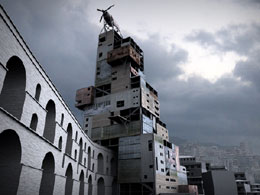COLUMNS
HIGH RISE
Project for the architectural competition Skyscraper 2009, organized by eVOLO magazine.
extrude architects (Dimitris Giouzepas, Panagiotis Gouliaris, Giannis Tsaras, Penny Chorafa)
http://www.extrude.gr/

Over the last years a growing concern has aroused, dealing with the declination of the environmental quality, caused among others, by the building construction activity. The environmental consequences of the construction of new buildings are known and noticed in a global level, as soon as the construction activity is responsible for the 40% of the total energy spent.
Apart from the consumption of energy and the alteration of the microclimate conditions caused by human constructions, there are several additional environmental after-effects that are not easily visible, unless the building activity exceeds its reasonable limits.
One of these consequences is the degradation of the quality of natural landscape. Especially in Greece this degradation seems to be rather obvious due to the excessive construction without programming and based on controversial architectural projects or proposals.

Moreover, human constructions engage soil and financially and ecologically valuable ground surface. As it is acknowledged, soil is considered among the non-renewable natural resources, necessary for cultivations but also for the self-sown, uncultivated natural vegetation of each special geographical location. Buildings tend to capture vast areas of ground surface eradicating it, while at the same time the soil quality is also decreased by the construction procedure.
Apart from the energy and the natural resources consumed during a building's lifetime in use, we shouldn't ignore the resources and the materials consumed during its construction. The nowadays way of merchandising and purchasing construction materials, promotes the use of specific and well defined ones, usually transported from distant areas. Therefore, rarely are local, traditional or alternative building methods concerned, using easy and accessible materials that every place can provide.

Another major environmental issue deals with the management of the debris of the demolished buildings. Millions of buildings are pulled down each year producing the equivalent amounts of waste and debris. Only in Greece the last five years, 34.211 demolition petitions were submitted (according to the national service of statistics), adding huge loads of construction wastes to an already vulnerable environment. Unfortunately, recycling of construction materials is till nowadays almost non-existing. Deconstructing, instead of demolishing, a building and re-use its components elsewhere, saves labor, natural resources, energy and money. The environmental impact is pretty important and encourages recycling in general.
One important conclusion that comes out is the need to restrain the problem by moderating the housing and therefore the construction needs. This moderation opposes to the ever growing request of quality of living which quality depends to the quality of the environment. Therefore, solutions are in demand in order to balance this

This proposal for the "skyscraper competition 2009" is an exploration of new ideas of innovative concepts for vertical density, by taking into account the urban fabric, the environmental impact, human scale and urban quality of living. The skyscraper through the years has become a symbol of wealth and power. In this case, we attempt to inverse this social context and redefine the main character of the skyscraper. Using cheap materials that have been used before and don't have a shiny appearance anymore, we create a whole new image of what a skyscraper could stand for as a social reflection. The form development of the building is guided by the natural pitch of the ground and imitates the urban complexity.

The major intention of the project is to re-use, by fitting in architectural elements, of older structures in new constructions. A new building structure could be covered by parts of facades of older buildings composing a new hole. In any case our intention was not a rational solution of the problem, but a reconsideration of the architectural composition problems, attached to the sustainability of construction. Our main aim is the production of a new field of research, which can emerge discussions related to subjects that the common environmental design is rarely dealing with.












